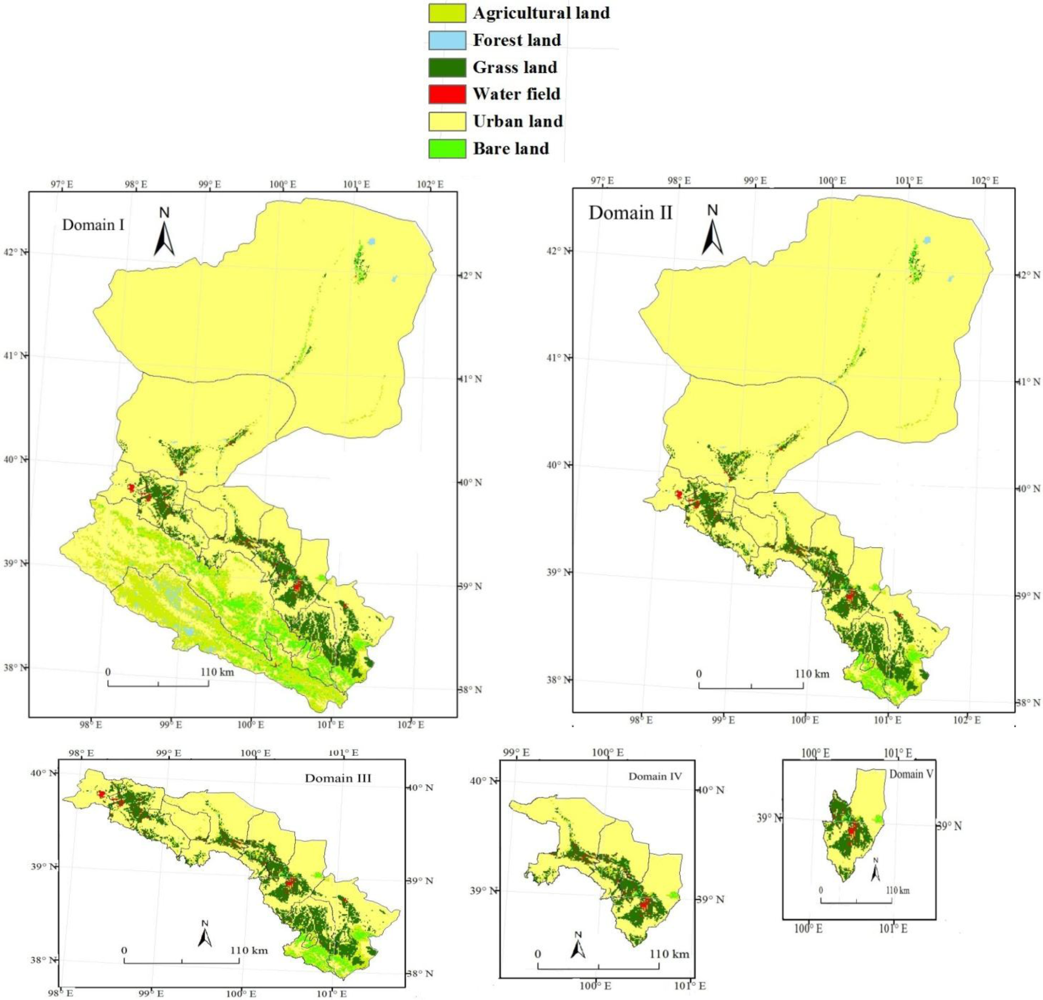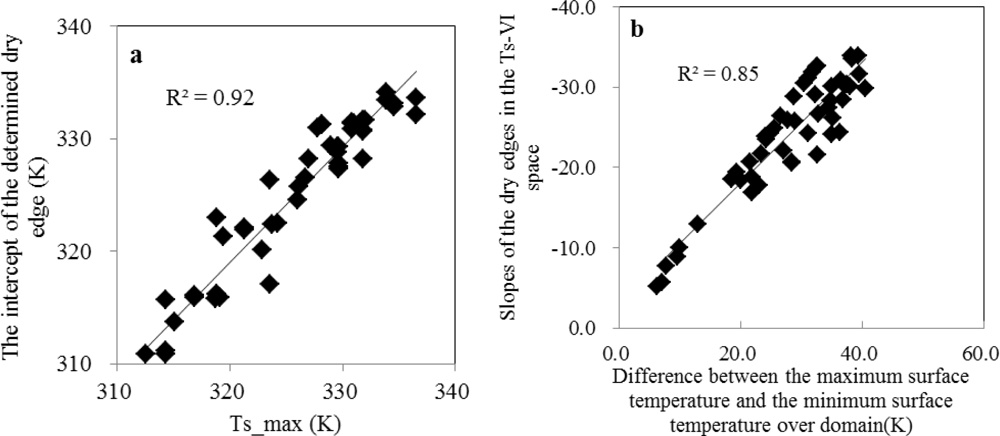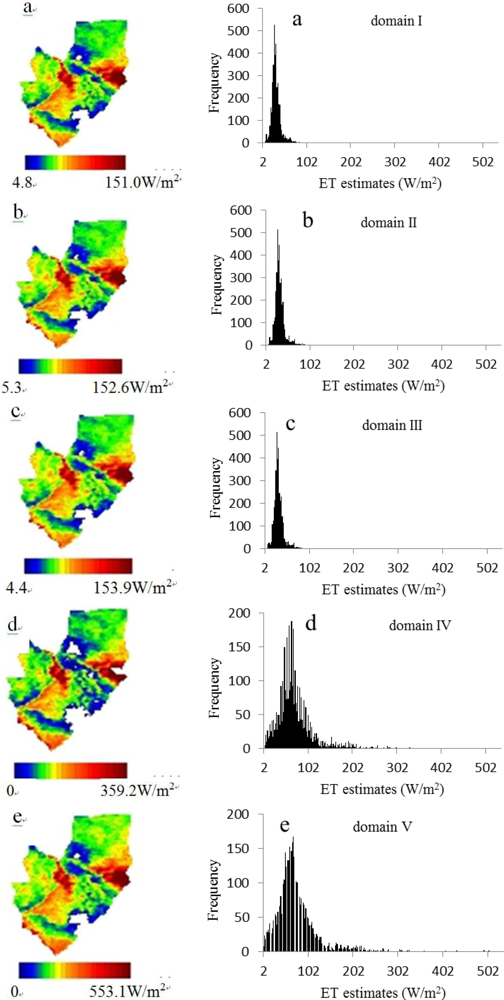4.1. Comparisons of Dry/Wet Edges Among Different Domain Sizes
Based on the T
s and
Fr images covering Domain I, II, III, IV and V, respectively, we obtained five sets of dry/wet edges for each of the 10 days.
Table 1 shows the statistics of the determined dry/wet edges and the maximum surface temperatures (
Ts_max) over each area for each day.
In general, a slight difference of the intercepts of dry edge for Domain I, II and III was found. Compared with the intercepts for Domain IV and V, Domain I, II and III have much higher values. This phenomenon can be related to
Ts_max corresponding to the five areas.
Figure 4(a) illustrates the relationship between the intercept of the determined dry edge and
Ts_max for the five areas for the 10 days. It displays a very good correlation coefficient (R
2), indicating high surface temperature of bare soil usually could lead to high intercepts of the dry edge.
Table 1 also shows
Ts_max are the highest for Domain I and II, followed in turn by Domain III, IV and V. As mentioned in Section 3.1, Gobi desert in Ejina and Jinta is the driest surface in the basin and therefore produced the highest
Ts_max for Domain I and II. Comparatively, the absence of extremely dry surface in Domain V results in the lowest intercept of the dry edge.
In addition, it can be seen from
Table 1 that the slopes of the dry edges for Domain I, II and III are quite different from those for Domain IV and V, especially for Domain V. The slopes for Domain I, II and III are obvious steeper than that for Domain IV and V, which means that the decrease of surface temperature due to the increase of
Fr happens much faster for Domain I, II and III. As mentioned in Section 2, the slope of the dry edge is determined by a linear regression between the maximum surface temperatures and the corresponding
Fr interval. In the case where there is a wide range of maximum surface temperature for a range of
Fr resulting from the combined effect of soil moisture, elevation, land use type, a steep slope of the dry edge would be produced. Generally speaking, the larger the domain size is, the more heterogeneous land surface is and thereby the steeper the slope of the dry edge is. The difference between
Ts_max and the minimum surface temperature (c in
Table 1) over the domain could represent the heterogeneity of land surface to a certain degree and was correlated with the slopes of the dry edges, as shown in
Figure 4(b). A good linear relationship was observed. It could be concluded that when enlarging the domain size, the slope of the dry edge tends to be steeper. When the extremely dry or wet surfaces are not available, the slope of the dry edge tends to be gentler.
The largest differences in slopes of the five domains were observed on DOY (day of year) 96, and 112. It is up to 27.5 K, 22.7 K between Domain I and V, respectively for the two days. The growing season of the dominant crops (maize and spring wheat) in the basin is from April to September. DOY 96 and 112 are at the early stage of the growing season. An absence of densely vegetated surfaces in Domain IV and V during the early stage of the crop growing season leads to a higher temperature for wet surfaces (see c value in
Table 1) by contrast with Domain I, II and III. This produces a narrower range of T
s on DOY 96 and 112, and therefore produces the gentler slopes. Values of (a–c) for Domain V for the two days are only 6.3 K and 7.6 K, while values of (a–c) are more than 20 K for the days in the middle of the growing season. The results indicate that the slope of the dry edge in T
s-VI space would be obviously overestimated during the early stage of crop growth or for the domain with no full vegetation cover. For Domain I, II and III, low surface temperatures of forest and grass land at high altitudes (
Figure 2–
3) contribute to the lower c values and thereby produce the larger (a–c) values and steeper slopes.
Similar to the largest difference of the slopes for the upper boundaries, the largest contrast in the lower boundaries were also observed between Domain I and V. On DOY 96 and 112, the differences of c values between Domain I and V are as large as 15∼20 K. This is consistent with the above description of the absence of extremely wet surface for Domain V at the beginning of the growing season.
4.2. Variation in ET Estimates with Domain Size
ET estimates from the triangle method is substantially dependent on the boundaries in the T
s-VI space via the
ϕ estimates from
Tmax,i and
Tmin,i using
Equations (1)–
(2). ET estimates from the domains that have an overlapping area were compared. For example, Domain V was compared with Domain I, II, III and IV. ET estimates of Domain IV were compared with that of Domain I, II and III, and so it is with ET estimates of Domain III and II.
Table 2 shows the statistics of the 10 pairs of ET estimates. For ET estimates of Domain V (
Table 2(a)), the smallest differences were observed between Domain IV and V, with an average RMSD of 16 W·m
−2 for the 10 days. The largest differences were found between Domain I and V, yielding an RMSD of 29 W·m
−2 for the 10-day average. This is consistent with the smallest difference in the limiting edges between Domain IV and V and the largest difference between Domain I and V (
Table 1). The comparison results among Domain I
versus V, II
versus V and III
versus V were very similar for the 10 days, which can be attributed to the similar dry/wet edges between them. When compared with the results at the beginning (DOY 96 and 112) of growing season for Domain I
versus V, II
versus V and III
versus V, the RMSD values in the middle of growing season were obvious lower. The maximum RMSD was identified for Domain I
versus V on DOY 96, with an RMSD of 66 W·m
−2. This can be explained by the larger difference of the dry/wet edges for the domains in the early stage of growing season and the smaller difference in the middle stage of growing season.
For the ET estimates in Domain IV (
Table 2(b)), the largest RMSD was found between Domain I and IV, with a ten-day average of 21 W·m
−2. Similar to the comparison of ET estimates for Domain V, the RMSD of ET estimates between Domain IV and the other three Domain I, II, III are also significantly higher at the beginning of growing season than in the middle, which is as high as 55 W·m
−2 on DOY 96.
When comparing the ET estimates for Domain II and III (
Table 2(c,d)), it gives much smaller RMSD than the prior comparisons. And the previously observed phenomenon of larger RMSD occurring at the beginning of growing season disappeared. This may be due to the similar limiting conditions among Domain I, II and III.
The trend of ET estimates with increasing domain size was not completely reflected from the mean difference of ET estimates between the five domain sizes. Some days exhibit positive values, while some days exhibit negative values.
The above results indicate that the difference of the dry/wet edges in the T
s-VI space may be a key contributor to the difference of ET estimates for domains with different sizes.
Figure 5 quantitatively illustrates the relationship between the difference of ET estimates of Domain IV and Domain V at different domain scales and the difference of the boundary conditions of the T
s-VI space. Apparently, differences in the slopes of the dry edges of the T
s-VI space (difference of b value in
Table 1) between Domain IV and Domain I, II, III are linearly correlated with the RMSD of ET estimates between them. Good linear correlation was also found between the differences of b values and the RMSD of ET estimates (
Table 2(a)) between Domain V and the other four domains. From
Figure 5(b), difference of the constant temperatures at the wet edges (difference of c value in
Table 1) is generally proportional to the values of RMSD of ET estimates between Domain IV and Domain I, II, III. So is the relationship for the differences of c values and the RMSD of ET estimates between Domain V and the other four domains. However, no linear relationship was found for ET estimates of Domain III and Domain II, which was not displayed in the paper. This is primarily because the dry/wet edges for Domain I, II and III are too similar to find significant differences. Overall, the dependence of the triangle method on the domain size is mostly originated from the dependence of the limiting edges on domain size.
Additionally, the average Pearson correlation coefficients (r) above 0.98 were found for each pair of ET estimates. This indicates that the difference of the determined limiting edges for different domain sizes has little impact on the spatial pattern of ET estimates. Even for the pair of Domain I and V, which has the largest contrast of the limiting edges, a high r value of 0.987 was obtained.
Figure 6 illustrates the five maps and the frequency histograms of ET estimates over the common overlapping Domain V on DOY 96 when the difference of ET estimates between different domain sizes are the largest. Similar distribution patterns were observed between the five sets of ET estimates, with higher ET in agricultural land and lower ET in bare land. It seems that the change of the limiting edges in T
s-VI space with domain size does not influence the spatial pattern of ET estimates. However, there are large differences in the magnitude of ET estimates between different domain sizes in terms of their histograms. Results explicitly revealed that ET estimates from Domain IV, V are much larger than that from Domain I, II and III on DOY 96, showing the areal mean of ET estimates of 72 W·m
−2, 76 W·m
−2, 32 W·m
−2, 33 W·m
−2 and 32 W·m
−2, respectively for Domain IV, V, I, II and III.












